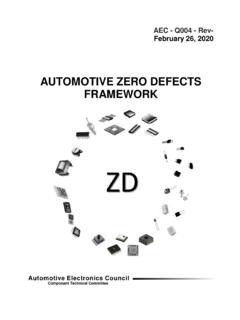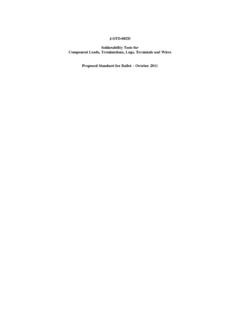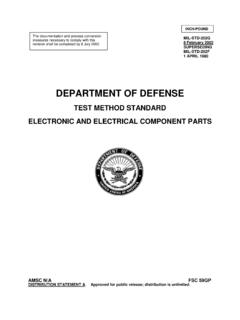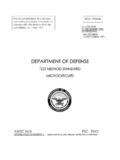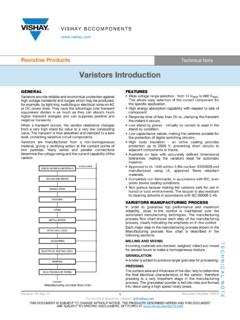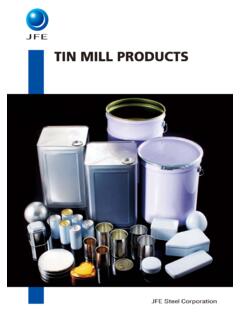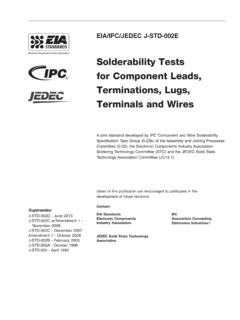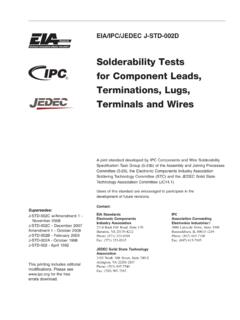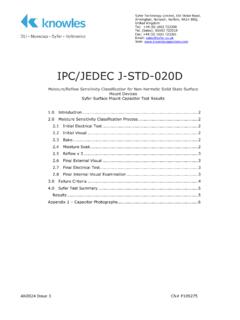Transcription of FAILURE MECHANISM BASED STRESS TEST QUALIFICATION …
1 AEC - Q102 - Rev A April 6, 2020 FAILURE MECHANISM BASED STRESS TEST QUALIFICATION FOR OPTOELECTRONIC SEMICONDUCTORS IN AUTOMOTIVE APPLICATIONS Component Technical CommitteeAutomotive Electronics Council AEC - Q102 - Rev A April 6, 2020 Component Technical CommitteeAutomotive Electronics CouncilTABLE OF CONTENTS AEC-Q102 FAILURE MECHANISM BASED STRESS Test QUALIFICATION for Optoelectronic Semiconductors in Automotive Applications Appendix 1: Definition of a QUALIFICATION Family Appendix 2: AEC-Q102 Certification of Design, Construction and QUALIFICATION Appendix 3: AEC-Q102 QUALIFICATION Test Plan Appendix 4: Data Presentation Format Appendix 5: Minimum Parametric Test Requirements and FAILURE Criteria Appendix 6: Destructive Physical Analysis (DPA) Appendix 7: AEC-Q102 and the Use of Mission Profiles Appendix 7a: Reliability Validation for Optoelectronic Semiconductors Attachments AEC-Q102-001: DEW TEST (DEW) AEC-Q102-002: BOARD FLEX TEST (BF) AEC-Q102-003.
2 OPTOELECTRONIC MULTICHIP MODULES (This attachment is not released at the time of the release of the AEC-Q102 Rev A main document. It is expected to be available in 2020.) AEC - Q102 - Rev A April 6, 2020 Component Technical CommitteeAutomotive Electronics CouncilAcknowledgment Any document involving a complex technology brings together experience and skills from many sources. The Automotive Electronics Council would especially like to recognize the following significant contributors to the revision of this document: AEC Q102 Sub-Committee Members: Ebru Bakir Kandemir Automotive Lighting Bastian Kopp Automotive Lighting Martin Martinez Automotive Lighting Marcus R hl Continental Corporation Mihai Sauciuc Continental Corporation Amber Abare Cree Steven Bergeron Cree Hartmut Wettengl Dominant Uwe Berger [Q102 Team Leader]
3 Hella Ludger Kappius Hella Martin Rode Hella Melanie Reinhout Lumileds Sven Schellinger Lumileds Mark Spencer Lumileds Mark Urlaub Lumileds Saori Mitsuhashi Nichia Philipp Plathner Osram Manfred Bittner Osram Opto Semiconductors Christian Jung Osram Opto Semiconductors Markus Ritzer Osram Opto Semiconductors Stefan Tuebel Osram Opto Semiconductors Jean-Edmont Le Calve Valeo Thomas Koschmieder Veoneer Martin G rtner Vishay Michael Pernkopf ZKW AEC - Q102 - Rev A April 6, 2020 Component Technical CommitteeAutomotive Electronics CouncilNOTICE AEC documents contain material that has been prepared, reviewed, and approved through the AEC Technical Committee.
4 AEC documents are designed to serve the automotive electronics industry through eliminating misunderstandings between manufacturers and purchasers, facilitating interchangeability and improvement of products, and assisting the purchaser in selecting and obtaining with minimum delay the proper product for use by those other than AEC members, whether the standard is to be used either domestically or internationally. AEC documents are adopted without regard to whether or not their adoption may involve patents or articles, materials, or processes. By such action AEC does not assume any liability to any patent owner, nor does it assume any obligation whatever to parties adopting the AEC documents.
5 The information included in AEC documents represents a sound approach to product specification and application, principally from the automotive electronics system manufacturer viewpoint. No claims to be in Conformance with this document shall be made unless all requirements stated in the document are met. Inquiries, comments, and suggestions relative to the content of this AEC document should be addressed to the AEC Technical Committee on the link Published by the Automotive Electronics Council. This document may be downloaded free of charge, however AEC retains the copyright on this material.
6 By downloading this file, the individual agrees not to charge for or resell the resulting material. Printed in the All rights reserved Copyright 2020 by the Sustaining Members of the Automotive Electronics Council. This document may be freely reprinted with this copyright notice. This document cannot be changed without approval from the AEC Component Technical Committee. AEC - Q102 - Rev A April 6, 2020 Page 1 of 57 Component Technical CommitteeAutomotive Electronics CouncilFAILURE MECHANISM BASED STRESS TEST QUALIFICATION FOR OPTOELECTRONIC SEMICONDUCTORS IN AUTOMOTIVE APPLICATIONS Text enhancements and differences made since the last revision of this document are shown as underlined areas.
7 Several figures and tables have also been revised, but changes to these areas have not been underlined. Unless otherwise stated herein, the date of implementation of this standard for new qualifications and re-qualifications is as of the publish date above. 1. SCOPE This document defines the minimum STRESS test driven QUALIFICATION requirements and references test conditions for QUALIFICATION of optoelectronic semiconductors ( , light emitting diodes, photodiodes, laser components (see Figure 1a & b)) in all exterior and interior automotive applications. It combines state of the art QUALIFICATION testing, documented in various documents ( , JEDEC, IEC, MIL-STD) and manufacturer QUALIFICATION standards.
8 The QUALIFICATION of multichip modules using optoelectronic functions together with other components ( , LEDs with integrated circuits, laser components with photodiodes, optocoupler) is described in Attachment AEC-Q102-003. (The document is not released at the time of the release of the AEC-Q102 rev. A main document, it is expected to be available in 2020) This document does not relieve the supplier of their responsibility to meet their own company's internal QUALIFICATION program. Additionally, this document does not relieve the supplier from meeting any user requirements outside the scope of this document.
9 In this document, "user" is defined as any company developing or using an optoelectronic semiconductor part in production. The user is responsible to confirm and validate all QUALIFICATION and assessment data that substantiates conformance to this document. Purpose The purpose of this document is to determine that a part is capable of passing the specified STRESS tests and thus can be expected to give a certain level of quality / reliability in the application. Reference Documents Current revision of the referenced documents will be in effect at the date of agreement to the QUALIFICATION plan.
10 Subsequent QUALIFICATION plans will automatically use updated revisions of these referenced documents. Automotive AEC-Q001 Guidelines for Part Average Testing AEC-Q002 Guidelines for Statistical Yield Analysis AEC-Q005 Pb-Free Test Requirements SAE/USCAR-33 Specification for testing LED Modules ZVEI Guideline for Customer Notifications of Product and/or Process Changes (PCN) of Electronic Components specified for Automotive Applications The following document from AEC-Q101 is respectively valid also for QUALIFICATION of optoelectronic semiconductors according to AEC-Q102.


